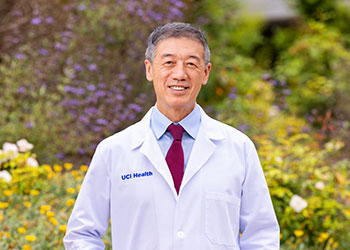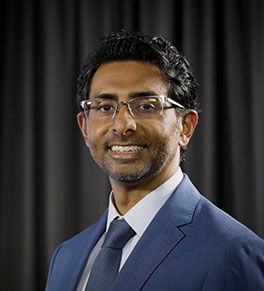Interventional Pulmonology Services
Our board-certified UCI Health interventional pulmonologists use minimally invasive techniques to diagnose and treat the full range of lung diseases. These include both cancer and benign (non-cancerous) diseases, such as:
- Severe asthma (reversible airway tightening)
- Chronic obstructive pulmonary disease (COPD, a group of lung diseases that block airflow leading to breathing difficulty)
- Interstitial lung disease (lung inflammation that may lead to irreversible scarring)
- Tracheal stenosis (narrowing of the large breathing tube)
- Pleural disease (problems with the lining tissue covering the lung and chest wall)
Most of these procedures are done by bronchoscopy, a procedure the allows the pulmonologist to look inside the lungs and visualize, diagnose and treat airway problems. Using a bronchoscope — a small, flexible fiberoptic camera that can be inserted into the mouth or nose to inspect a person’s airway — a pulmonologist can detect tumors, signs of infection, excess mucus or blocked airways. It also allows the physician to take tissue samples from the airways for testing.
For more information about Interventional Pulmonology Services or to make an appointment, please call
714-456-8000.
Lung cancer
Bronchoscopy is an important tool in the fight against lung cancer, which is the leading cause of cancer-related deaths in the United States. Currently, curative treatments are possible only for lung cancer diagnosed in its early stages. Because this disease can go unnoticed for many years, many patients are diagnosed at an advanced stage. Learn more about our lung cancer services.
Our interventional pulmonology team seeks to identify and diagnose patients earlier in the disease process through these minimally invasive diagnostic options. We also seek to extend the life and health of patients with lung cancer and its related problems by providing novel therapeutic treatment options and supportive care throughout a person’s individual journey.
Advanced treatments
We work closely with a dedicated team of cancer specialists, including medical oncologists, radiation oncologists, surgeons and other providers at the UCI Health Chao Family Comprehensive Cancer Center to offer advance treatments that help people with lung cancer live longer and with fewer symptoms.
Our lung cancer team also is actively involved in multiple research projects and clinical trials. Through these trials, we seek to give patients better diagnostic and treatment options —as well as access to therapies that improve their quality of life and offer relief from pain and discomfort — long before they are available to the general public.
Innovation
Our team is one of the first in the state to perform minimally invasive therapeutic procedures with a specialized airway recannulization and tumor debulking device. The heat-based catheter technology, which uses monopolar radiofrequency, allows patients to undergo same day, outpatient procedures to remove both cancerous and non-cancerous tissue blocking portions of their lungs. By removing these obstructing lesions, patients are able to breathe better, cough less and have fewer complications, such as pneumonia or coughing up blood from their tumor.
Learn more about our team of pulmonologists
Procedures
Our interventional pulmonologists perform the following procedures:
- Flexible bronchoscopy — We use flexible bronchoscopy to inspect a patient's airway. It can also be used to perform washings or biopsies (extraction of small pieces of tissue) of the airway tissue to look for infection, inflammation or cancer.
- Rigid bronchoscopy — Using a solid, metal tube with a camera and light source, a rigid bronchoscopy allows for direct visualization of the airway and for a variety of diagnostic and therapeutic techniques. These options include removal of foreign objects inhaled into the airway and airway recannulization, which opens breathing tubes blocked by tumor, infection or scar tissue.
- Endobronchial ultrasound (EBUS) and radial probe endobronchial ultrasound (REBUS) — With EBUS, the pulonologist uses a bronchoscope equipped with ultrasound technology. This technique allows biopsies to be performed in multiple areas with much greater accuracy. Because the needle can be visualized within the abnormality of interest, the risk of puncturing a blood vessel or damaging lung tissue is minimized. This procedure also is used to biopsy lymph nodes (tissue swellings) in the middle of the chest (EBUS) or peripheral lung lesions (REBUS).
- Electromagnetic navigation bronchoscopy (EMN) — We use the superDimension™ electromagnetic navigation system to gain access to peripheral lung lesions and mediastinal lymph nodes for patients who are unable to undergo more invasive procedures, who may have multiple lesions or who need a formal diagnosis before a more invasive surgery. This image-guided technique uses a virtual airway system to pinpoint and target lesions and facilitate accurate biopsies.
- EMN or EBUS placement of fiducial markers for stereotactic radiation — Some tumors are not accessible or manageable with traditional surgical approaches. These types of lesions are excellent candidates for stereotactic radiosurgery in which radiation therapy is delivered precisely to the tumor, enabling patients to receive needed care. Placement of fiducial markers (tiny metal clips) around the tumor allows for more precise delivery of radiation therapy to prevent damage to surrounding healthy lung tissue.
- Bronchial thermoplasty (BT) — Bronchial thermoplasty is an FDA-approved, nonpharmacological treatment for patients who suffer from severe, persistent asthma that is poorly controlled with inhaled corticosteroids and long-acting beta agonists, which are the current standard-of-care treatments. Bronchial thermoplasty uses radiofrequency energy to relieve asthma symptoms by heating the smooth muscle walls of the airway. This technique thins the walls without scarring or damage, effectively preventing narrowing of the airways when irritants trigger asthma attacks. This technique results in fewer asthma symptoms and greater relief.
- Argon plasma coagulation (APC) — With this noncontact method, a catheter system delivers argon gas into airways to destroy tumors or other lesions and prevent bleeding. Because it covers a large surface area, procedure time is decreased.
- Balloon dilation — Using a bronchoscope, a small balloon is placed into a narrowed airway to open it up wider. Airway narrowing can lead to many different symptoms, including shortness of breath, poor exercise ability, voice change or coughing.
- Cryosurgery and spray cryotherapy — Using either a rigid or flexible bronchoscope, cryotherapy destroys airway lesions by freezing tissue. In cryosurgery, a probe tip is rapidly cooled by nitrous oxide or carbon dioxide and applied directly to the lesion to remove it. Spray cryotherapy uses liquid nitrogen to spray an area of concern and cause cryonecrosis, or tissue death by rapid freezing. These procedures are used together with APC and balloon dilation to open a blocked airway.
- Airway stenting — Stents are small, cylindrical, expandable tubes, very similar to those used by cardiologists to open arteries in the heart. Interventional pulmonologists use stents to open breathing tubes that are narrowed by infection, tumors or scar tissue.
- Transbronchial cryobiopsy — Interstitial lung disease (ILD) represents a rare group of lung problems caused when the supporting structure of the lung tissue, or interstitium, is abnormal for various reasons. Using a flexible bronchoscope and cryoprobe, tissue at the edge of the lung is biopsied to determine the underlying cause of the ILD and help guide treatment. This procedure is beneficial for a patient who is unable to undergo surgery or would prefer a noninvasive approach before undergoing a surgical lung biopsy.
- Medical thoracoscopy — When laparoscopy is performed in the chest it is called medical thoracoscopy or pleuroscopy. A small instrument with a camera is inserted into the chest cavity through a very small incision, enabling the physician to perform diagnostic and therapeutic procedures inside the chest, including pleural biopsies for diagnostic purposes, placement of chest tubes to allow for fluid to be removed over time, and pleurodesis, or fusion of the two pleural layers, to prevent fluid or air from building up again.
- Tunneled pleural catheter — When pleural fluid accumulates persistently in the pleural space, lung tissue can be compressed, making patients feel short of breath, able to do fewer activities, and develop a cough. Placing a tunneled pleural catheter under the skin in the side of the chest wall and into this space allows the fluid to drain, leading to improved quality of life.
- Endobronchial valves — The Spiration® endobronchial valve device has been approved by the U.S. Food and Drug Administration (FDA) for humanitarian use to control prolonged air leaks of the lung after lobectomy, segmentectomy or lung volume reduction surgery. This FDA Humanitarian Device Exemption is the first for a bronchial valve procedure. Its effectiveness has not yet been confirmed.











